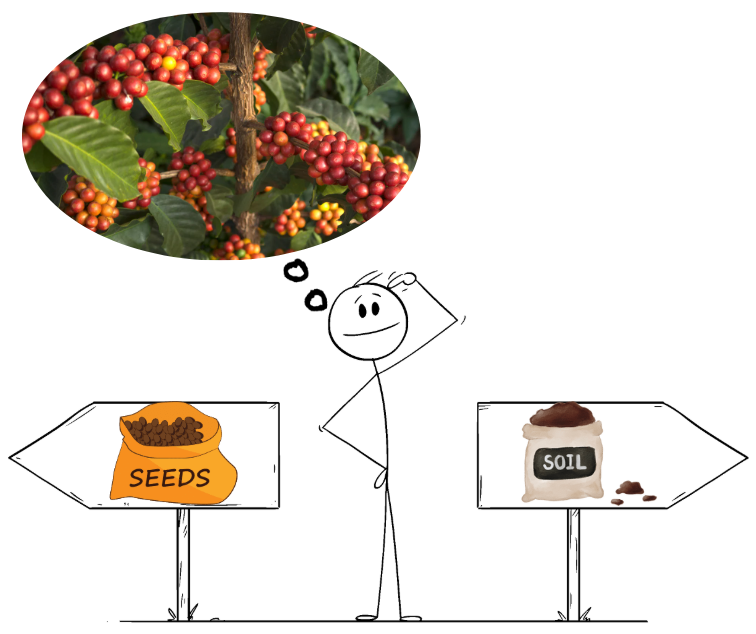
Coffee Replanting: Which Varieties to Choose and How to Prepare the Soil to Prevent Plant Death?
Replanting (or rejuvenating) coffee plantations is essential when trees become old, unproductive, disease-prone, and produce low-quality beans.
However, if the soil is not properly treated or if unsuitable varieties are selected, the risk of large-scale seedling death after replanting is extremely high.
👉 So how should you prepare the soil to prevent fungal infection?
Which varieties are drought-tolerant and rust-resistant?
Let’s explore all the answers below.
⚠️ Why Do Coffee Plants Often Die After Replanting?

- Residual nematodes and fungal pathogens in old soil
- Old root remnants not fully decomposed → root rot in new seedlings
- Soil acidification and loss of beneficial microorganisms
- New varieties unsuited to local soil and climate
- Incorrect planting time or technique
✅ Therefore, proper soil preparation and variety selection are critical for successful replanting.
🧱 1. Proper Soil Preparation for Coffee Replanting

📅 Best time for replanting:
From the end of the rainy season to the beginning of the dry season (October–December)
→ Ensures young plants establish roots before the heat of the dry season.
🌿 Steps for soil rehabilitation:
- Remove all old coffee stumps and major roots.
- Expose soil to sunlight for 3–6 months — ideally grow forage grass or legumes during this time.
- Apply 2–3 tons/ha of lime to reduce acidity and kill pathogens.
- Incorporate decomposed manure + Trichoderma to eliminate soil fungi.
- If possible, rotate crops (corn, mung bean, soybean) for 1–2 seasons before replanting.
🔍 Notes:
- Never plant directly over the old coffee stump.
- Maintain spacing of 3.0 × 3.0 m or 3.5 × 3.5 m, depending on location.
- Consider intercropping with pepper, durian, or windbreak trees such as Acacia auriculiformis.
🌱 2. Recommended Coffee Varieties for Replanting

🔥 High-performing and rust-resistant varieties
|
Variety |
Key Traits |
Yield Potential |
|
TR4 |
Excellent rust resistance, large fruits |
4–5 tons/ha |
|
TR9 |
Uniform ripening, large beans |
5–6 tons/ha |
|
LĐ5 |
Vigorous growth, high yield |
4.5–5.5 tons/ha |
|
THA1 |
Strong branches, tolerant to poor soils |
~4 tons/ha |
📌 Important tips:
- Choose varieties from certified research institutes or reputable nurseries.
- Avoid using seeds from old or mixed plantations → low and inconsistent yield.
- Select rust-resistant varieties to minimize fungicide dependence.
🔬 3. Planting Techniques After Replanting

- Dig holes at least 30–45 days before planting, size 60 × 60 × 60 cm.
- Base fertilizer: 10–15 kg decomposed manure + lime + biofertilizer per hole.
- Use nursery-grown seedlings (30–40 cm tall, with 6–7 true leaves).
- Provide shade for 2–3 weeks and maintain light, consistent moisture.
🚫 Avoid these common mistakes:
❌ Planting seedlings at midday under strong sun
❌ Ignoring nematode/fungal soil treatment → young plant death
❌ Using unknown or untested seed sources → degeneration risk
❌ Over-fertilizing with nitrogen → rapid but weak growth
📌 Conclusion
💬 “Replanting coffee isn’t just about planting new trees — it’s about rebuilding the entire soil and ecosystem.”
Farmers should always remember:
✅ Thoroughly rehabilitate soil before replanting
✅ Rotate crops for at least one season if possible
✅ Choose high-yield, disease-resistant varieties
✅ Follow correct planting and early care techniques
Bình luận
Những bình luận mới nhất



